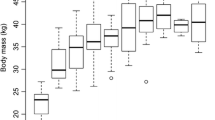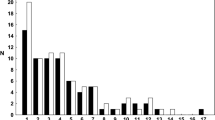Abstract
Although numerous studies have reported reproductive senescence in wild animal populations, we still know very little on inter-individual differences in rates of ageing and on the factors accounting for these differences. To investigate age-related variation in breeding success in a natural population of Alpine chamois (Rupicapra rupicapra), we used 15 years of data obtained by monitoring individual ear-tagged females. Analyses at the population level confirmed the occurrence of a decline in female breeding success, which is most noticeable from 9 years of age onward. Using an age-reverse approach, we showed that senescence in female breeding success occurs at the same age, since only very old individuals (older than 16 years) showed a decline in breeding success in the years preceding death. Interestingly, we also found evidence that ‘success comes from success’, as females that gave birth in a given year were more likely to procreate again in the following year. Moreover, results showed that discrepancies between successful and unsuccessful individuals tend to become more relevant in the oldest age classes. There was no evidence of a terminal allocation. These results emphasize the importance of age-dependent effects and individual quality in shaping reproductive senescence in a wild long-lived ungulate.



Similar content being viewed by others
References
Bates D, Maechler M, Bolker B, Walker S (2014) lme4: linear mixed-effects models using Eigen and S4. R package version 1.0-6. http://CRAN.R-project.org/package=lme4
Beauplet G, Barbraud C, Dabin W, Küssener C, Guinet C (2006) Age-specific survival and reproductive performances in fur seals: evidence of senescence and individual quality. Oikos 112:430–441
Berman M, Gaillard JM, Weimerskirch H (2009) Contrasted patterns of age-specific reproduction in long-lived seabirds. Proc R Soc B Biol Sci 276:375–382
Bize P, et al. (2014) Senescence in cell oxidative status in two bird species with contrasting life expectancy. Oecologia 174:1097–1105
Bouwhuis S, Sheldon BC, Verhulst S, Charmantier A (2009) Great tits growing old: selective disappearance and the partitioning of senescence to stages within the breeding cycle. Proc R Soc B Biol Sci 276:2769–2777
Clutton-Brock TH (1984) Reproductive effort and terminal investment in iteroparous animals. Am Nat 123:212–229
Clutton-Brock TH, Guinness FE, Albon SD (1983) The costs of reproduction to red deer hinds. J Anim Ecol 52:367–383
Clutton-Brock TH, Albon SD, Guinness FE (1989) Fitness costs of gestation and lactation in wild mammals. Nature 337:260–262
Corlatti L, Lebl K, Filli F, Ruf T (2012) Unbiased sex-specific survival in Alpine chamois. Mamm Biol 77:135–139
Coulson JC, Fairweather JA (2001) Reduced reproductive performance prior to death in the black-legged kittiwake: senescence or terminal illness? J Avian Biol 32:146–152
Daan S, Deerenberg C, Dijkstra C (1996) Increased daily work precipitates natural death in the kestrel. J Anim Ecol 65:539–544
Festa-Bianchet M (1989) Individual differences, parasites, and the costs of reproduction for bighorn ewes (Ovis canadensis). J Anim Ecol 58:785–795
Froy H, Phillips RA, Wood AG, Nussey DH, Lewis S (2013) Age-related variation in reproductive traits in the wandering albatross: evidence for terminal improvement following senescence. Ecol Lett 16:642–649
Hamel S, Côté SD (2009) Foraging decisions in a capital breeder: trade-offs between mass gain and lactation. Oecologia 161:421–432
Hirshfield MF, Tinkle DW (1975) Natural selection and the evolution of reproductive effort. Proc Natl Acad Sci 72:2227–2231
Jones OR, et al. (2008) Senescence rates are determined by ranking on the fast-slow life-history continuum. Ecol Lett 11:664–673
Lent PC (1974) Mother-infant relationships in ungulates. In: Geist V, Walther F (eds) The behaviour of ungulates and its relation to management. IUCN, Morges, pp 14–55
Loison A, Festa-Bianchet M, Gaillard J-M, Jorgenson JT, Jullien J-M (1999a) Age-specific survival in five populations of ungulates: evidence of senescence. Ecology 80:2539–2554
Loison A, Jullien J-M, Menaut P (1999b) Subpopulation structure and dispersal in two populations of chamois. J Mammal 80:620–632
Martin JGA, Festa-Bianchet M (2011) Age-independent and age-dependent decreases in reproduction of females. Ecol Lett 14:576–581
Mason THE, Chirichella R, Richards SA, Stephens PA, Willis SG, Apollonio M (2011) Contrasting life histories in neighbouring populations of a large mammal. PLoS ONE 6:e28002
McElligott AG, Altwegg R, Hayden TJ (2002) Age-specific survival and reproductive probabilities: evidence for senescence in male fallow deer (Dama dama). Proc R Soc B Biol Sci 269:1129–1137
Muggeo VMR (2008) Segmented: an R package to fit regression models with broken-line relationships. R News 8:20–25
Mysterud A, Steinheim G, Yoccoz NG, Holand Ãy, Stenseth NC (2002) Early onset of reproductive senescence in domestic sheep Ovis aries. Oikos 97:177–183
Nussey DH, Froy H, Lemaitre JF, Gaillard JM, Austad SN (2013) Senescence in natural populations of animals: widespread evidence and its implications for bio-gerontology. Ageing Res Rev 12:214–225
R Development Core Team (2012) R: a language and environment for statistical computing. R Foundation for Statistical Computing, Vienna
Reed TE, Kruuk LEB, Wanless S, Frederiksen M, Cunningham EJA, Harris MP (2008) Reproductive senescence in a long-lived seabird: rates of decline in late-life performance are associated with varying costs of early reproduction. Am Nat 171:E89–E101
Reznick D, Nunney L, Tessier A (2000) Big houses, big cars, superfleas and the costs of reproduction. Trends Ecol Evol 15:421–425
Robinson MR, Mar KU, Lummaa V (2012) Senescence and age-specific trade-offs between reproduction and survival in female Asian elephants. Ecol Lett 15:260–266
Ruckstuhl K, Ingold P (1994) On the suckling behaviour of Alpine chamois Rupicapra rupicapra rupicapra. Zeitschr Säugetierkd 59:230–235
Ruckstuhl KE, Ingold P (1999) Aspects of mother-kid behavior in Alpine chamois, Rupicapra rupicapra rupicapra. Zeitschr Säugetierkd 64:76–84
Rughetti M, Festa-Bianchet M (2010) Compensatory growth limits opportunities for artificial selection in Alpine chamois. J Wildl Manage 74:1024–1029
Santos ESA, Nakagawa S (2012) The costs of parental care: a meta-analysis of the trade-off between parental effort and survival in birds. J Evol Biol 25:1911–1917
Schröder W, von Elsner-Schack I (1985) Correct age determination in chamois. In: Lovari S (ed) The biology and management of mountain ungulates. Croom Helm, London, pp 67–70
Stearns SC (1989) Trade-offs in life-history evolution. Funct Ecol 3:259–268
Stearns S (1992) The evolution of life histories. Oxford University Press, Oxford, New York
van de Pol M, Verhulst S (2006) Age-dependent traits: a new statistical model to separate within- and between-individual effects. Am Nat 167:766–773
Vaupel JW, Manton KG, Stallard E (1979) The impact of heterogeneity in individual frailty on the dynamics of mortality. Demography 16:439–454
Weladji RB et al (2006) Good reindeer mothers live longer and become better in raising offspring. Proc R Soc B Biol Sci 273:1239–1244
Weladji RB et al (2008) Heterogeneity in individual quality overrides costs of reproduction in female reindeer. Oecologia 156:237–247
Acknowledgments
We are grateful to all the park rangers of the Swiss National Park, especially Fadri Bott, for their work on marking and re-sighting chamois. This project was partially supported by the Italian Ministry of Education, University and Research (PRIN 2010-2011, 20108 TZKHC). F. T. was the recipient of a PhD fellowship from the University of Sassari. S. G. had the support of the P.O.R. F.S.E. 2007-2013—Obiettivo competitività regionale e occupazione. Asse IV Capitale umano—Linea di attività 1.3.1 fund. We are grateful to Jean-Michel Gaillard, Marco Festa-Bianchet and an anonymous referee for their helpful suggestions on the paper. The English version was edited by G. Falceri.
Ethical standards
Female Alpine chamois were tagged by rangers of the Swiss National Park under the legal authorization of the Swiss Veterinary Office.
Author information
Authors and Affiliations
Corresponding author
Additional information
Communicated by Jean-Michel Gaillard.
Rights and permissions
About this article
Cite this article
Tettamanti, F., Grignolio, S., Filli, F. et al. Senescence in breeding success of female Alpine chamois (Rupicapra rupicapra): the role of female quality and age. Oecologia 178, 187–195 (2015). https://doi.org/10.1007/s00442-014-3197-y
Received:
Accepted:
Published:
Issue Date:
DOI: https://doi.org/10.1007/s00442-014-3197-y




